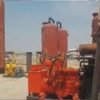TORONTO: Delta Air Lines jet with 80 people onboard crash-landed Monday at Toronto’s main airport, officials said, flipping upside down and leaving at least 18 people injured but causing no deaths.
Three people on the flight that originated at Minneapolis-St. Paul International Airport suffered critical injuries, among them a child, a Canadian air ambulance official added, with 15 others also immediately taken to hospitals.
Passenger John Nelson posted a video of the aftermath on Facebook, showing a fire engine spraying water on the plane that was lying belly-up on the snow-covered tarmac.
He later told CNN there was no indication of anything unusual before landing.
“We hit the ground, and we were sideways, and then we were upside down,” Nelson told the television network.
“I was able to just unbuckle and sort of fall and push myself to the ground. And then some people were kind of hanging and needed some help being helped down, and others were able to get down on their own,” he said.
WEATHER CONDITIONS
Pearson Airport said earlier on Monday it was dealing with high winds and frigid temperatures as airlines attempted to catch up with missed flights after a weekend snowstorm dumped more than 22 cm (8.6 inches) of snow at the airport.
The Delta plane touched down in Toronto at 2:13 p.m. (1913 GMT) after an 86-minute flight and came to rest near the intersection of runway 23 and runway 15, FlightRadar24 data showed.
The reported weather conditions at time of the crash indicated a “gusting crosswind and blowing snow,” the flight tracking website said.
Toronto Pearson Fire Chief Todd Aitken said late on Monday the runway was dry and there were no crosswind conditions, but several pilots Reuters spoke to who had seen videos of the incident pushed back against this comment.
U.S. aviation safety expert and pilot John Cox said there was an average crosswind of 19 knots (22 mph) from the right as it was landing, but he noted this was an average, and gusts would go up and down.
“It’s gusty so they are constantly going to have to be making adjustments in the air speed, adjustments in the vertical profile and adjustments in the lateral profile,” he said of the pilots, adding that “it’s normal for what professional pilots do.”
Investigators would try to figure out why the right wing separated from the plane, Cox said.
Michael J. McCormick, associate professor of air traffic management at Embry-Riddle Aeronautical University, said the upside-down position made the Toronto crash fairly unique.
“But the fact that 80 people survived an event like this is a testament to the engineering and the technology, the regulatory background that would go into creating a system where somebody can actually survive something that not too long ago would have been fatal,” he said.
Three previous cases of planes flipping over on landing involved McDonnell-Douglas’s MD-11 model. In 2009, a FedEx freighter turned over on landing at Tokyo’s Narita airport killing both pilots. In 1999, a China Airlines flight inverted at Hong Kong, killing three of 315 occupants. In 1997, another FedEx freighter flipped over at Newark with no fatalities.



